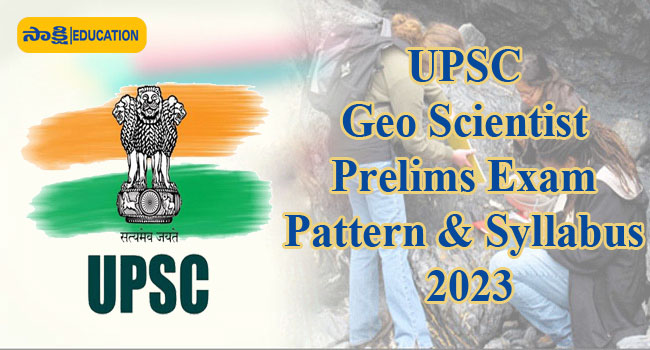UPSC Geo Scientist Prelims Exam Pattern & Syllabus 2023

Plan of Examination: The Combined Geo-Scientist Examination will consist of three successive stages
Stage-I: Combined Geo-Scientist (Preliminary) Examination (Objective type) having two papers for selection of the candidates for the Combined Geo-Scientist (Main) Examination. Marks secured in the Preliminary Examination will be counted for deciding the final merit;
Stage-II: Combined Geo-Scientist (Main) Examination (Descriptive Type) having three papers for selection of candidates for the Personality Test (Stage-III). Marks secured in the Main Examination will be counted for deciding the final merit; and
Stage-III: Personality Test/Interview
Stage-I: Preliminary Examination
|
Stream-I : Geologist & Scientist B (Hydrogeology) |
||
|
Subject |
Duration |
Maximum Marks |
|
Paper-I: General Studies |
2 Hours |
100 Marks |
|
Paper-II: Geology/Hydrogeology |
2 Hours |
300 Marks |
|
Stream-II : Geophysicist and Scientist ‘B’(Geophysics) |
||
|
Paper-I: General Studies |
2 Hours |
100 Marks |
|
Paper-II: Geophysics |
2 Hours |
300 Marks |
|
Stream-III : Chemist and Scientist ‘B’(Chemical) |
||
|
Paper-I: General Studies |
2 Hours |
100 Marks |
|
Paper-II: Chemistry |
2 Hours |
300 Marks |
Penalty for wrong answers (in Objective Type Papers): Candidates should note that there will be penalty (Negative Marking) for wrong answers marked by a candidate in the Objective Type Question Papers.
Syllabus of Combined Geo-Scientist (Preliminary) Examination
Paper-I: General Studies (Common for all streams)
Current events of national and international importance.
History of India and Indian National Movement.
Indian and World Geography -Physical, Social, Economic Geography of India and the World.
Indian Polity and Governance -Constitution, Political System, Panchayati Raj, Public Policy, Rights Issues, etc.
Economic and Social Development – Sustainable Development, Poverty, Inclusion, Demographics, Social Sector initiatives, etc.
General issues on Environmental Ecology, Bio-diversity and Climate Change - that do not require subject specialisation
General Science
Paper-II: Geology/Hydrogeology
1. Physical Geology: Principle of uniformitarianism; origin, differentiation and internal structure of the Earth; origin of atmosphere; earthquakes and volcanoes; continental drift, sea-floor spreading, isostasy, orogeny and plate tectonics; geological action of rivers, wind, glaciers, waves; erosional and depositional landforms; weathering processes and products.
2. Structural Geology: Stress, strain and rheological properties of rocks; planar and linear structures; classification of folds and faults; Mohr's circle and criteria for failure of rocks; ductile and brittle shear in rocks; study of toposheets, V-rules and outcrop patterns; stereographic projections of structural elements.
3. Mineralogy: Elements of symmetry, notations and indices; Bravais lattices; chemical classification of minerals; isomorphism, polymorphism, solid solution and exsolution; silicate structures; physical and optical properties of common rock forming minerals- olivine, garnet, pyroxene, amphibole, mica, feldspar and quartz.
4. Igneous Petrology: Magma types and their evolution; IUGS classification of igneous rocks; forms, structures and textures of igneous rocks; applications of binary and ternary phase diagrams in petrogenesis; magmatic differentiation and assimilation; petrogenesis of granites, basalts, komatiiites and alkaline rocks (carbonatite, kimberlite, lamprophyre and nepheline syenite).
5. Metamorphic Petrology: Limits, types and controls of metamorphism; metamorphic structures- slate, schist and gneiss; metamorphic textures- pre, syn and post tectonic porphyroblasts; concept of metamorphic zone, isograd and facies; geothermal gradients, facies series and plate tectonics.
6. Sedimentology: Origin of sediments; sedimentary textures, grain-size scale; primary sedimentary structures; classification of sandstone and carbonate rocks; siliciclastic depositional environments and sedimentary facies; diagenesis of carbonate sediments.
7. Paleontology: Fossils and processes of fossilization; concept of species and binomial nomenclature; morphology and classification of invertebrates (Trilobites, Brachiopods, Lamellibranchs, Gastropods and Cephalopods); evolution in Equidae and Hominidae; microfossils-Foraminifera, Ostracoda; Gondwana flora.
8. Stratigraphy: Law of superposition; stratigraphic nomenclature- lithostratigraphy, biostratigraphy and chronostratigraphy; Archaean cratonic nucleii of Peninsular India (Dharwar, Singhbhum, and Aravalli cratons); Proterozoic mobile belts (Central Indian Tectonic Zone, Aravalli-Delhi and Eastern Ghats); Purana sedimentary basins (Cuddapah and Vindhyan); Phanerozoic stratigraphy of IndiaSpiti, Kashmir, Damodar valley, Kutch, Trichinopoly, Siwaliks and Indo-Gangetic alluvium.
9. Economic Geology: Properties of mineral deposits- form, mineral assemblage, texture, rock-ore association and relationship; magmatic, sedimentary, metamorphic, hydrothermal, supergene and weatheringrelated processes of ore formation; processes of formation of coal, and petroleum; distribution and geological characteristics of major mineral and hydrocarbon deposits of India.
10. Hydrogeology: Groundwater occurrence and aquifer characteristics, porosity, permeability, hydraulic conductivity, transmissivity; Darcy's Law in homogenous and heterogenous media; Bernoulli equation, Reynold's number; composition of groundwater; application of H and O isotopes in groundwater studies; artificial recharge of groundwater.
Paper-II: Geophysics
1. Solid Earth Geophysics: Introduction to Geophysics and its branches. Solar system: origin, formation and characteristics of planets, Earth: shape and rotation. Gravity and magnetic fields of earth. Geomagnetism, elements of earth's magnetism, Rock and mineral magnetism, Elastic waves, types and their propagation characteristics, internal structure of earth, variation of physical properties in the interior of earth. Plate tectonics, Earthquakes and their causes, focal depth, epicenter, Intensity and Magnitude scales, Energy of earthquakes, Seismicity.
2. Mathematical Methods in Geophysics: Elements of vector analysis, Vector algebra, Properties of scalars, vectors and tensors, Gradient, Divergence and Curl, Gauss's divergence theorem, Stoke’s theorem. Matrices, Eigen values and Eigen vectors and their applications in geophysics. Newton's Law of gravitation, Gravity potential and gravity fields due to bodies of different geometric shapes. Basic Forces of Nature and their strength: Gravitational, Electromagnetic, Strong and Weak forces. Conservation Laws in Physics: Energy, Linear and angular momentum. Rigid body motion and moment of inertia. Basics of special theory of relativity and Lorentz transformation. Fundamental concepts of inverse theory, Definition of inversion and application to Geophysics. Forward and Inverse problems. Probability theory, Random variables, binomial, Poisson and normal distributions. Linear algebra, Linear ordinary differential equations of first and second order. Partial differential equations (Laplace, wave and heat equations in two and three dimensions). Elements of numerical techniques: root of functions, interpolation, and extrapolation, integration by trapezoid and Simpson's rule, solution of first order differential equation using Runge-Kutta method, Introduction to finite difference and finite elements methods.
3. Electromagnetism: Electrostatic and magneto-static fields, Coulomb's law, Electrical permittivity and dielectric constant, Lorentz force and their applications. Ampere's law, Biot and Savart's law, Gauss’s Theorem, Poisson's equation. Laplace's equation: solution of Laplace's equation in Cartesian coordinates, use of Laplace's equation in the solutions of geophysical and electrostatic problems. Displacement current, Faraday's law of electromagnetic induction. Maxwell's equations. Boundary conditions. Wave equation, plane electromagnetic waves in free space, dielectric and conducting media, electromagnetic vector and scalar potentials.
4. Geophysical Prospecting: Elements of geophysical methods: Principles, data reduction and applications of gravity, magnetic, electrical, electromagnetic and well logging methods. Fundamentals of seismic methods: Fermat’s Principle, Snell’s Law, Energy portioning, Reflection and transmission coefficients, Reflection and Refraction from layered media. Signals and systems, sampling theorem, aliasing effect, Fourier series and periodic waveforms, Fourier transform and its application, Laplace transforms, Convolution, Auto and cross correlations, Power spectrum, Delta function, unit step function.
5. Remote Sensing and Thermodynamics: Fundamentals of remote sensing, electromagnetic spectrum, energy- frequency-wavelength relationship, Stefan-Boltzmann Law, Wien’s Law, electromagnetic energy and its interactions in the atmosphere and with terrain features. Planck’s Radiation Law. Laws of thermodynamics and thermodynamic potential. 6. Nuclear Physics and Radiometry: Basic nuclear properties: size, shape, charge distribution, spin and parity; Binding energy, semi-empirical mass formula; Fission and fusion. Principles of radioactivity, Alpha, beta and gamma decays, Photoelectric and Compton Effect, Pair Production, radioactivity decay law, radioactivity of rocks and minerals, Radiation Detectors: Ionization chamber, G-M counter, Scintillation counter and Gamma ray spectrometer. Matter Waves and wave particle duality, Electron spin, Spectrum of Hydrogen, helium and alkali atoms.
Paper-II: Chemistry
1. Chemical periodicity: Schrödinger equation for the H-atom. Radial distribution curves for 1s, 2s, 2p, 3s, 3p, 3d orbitals. Electronic configurations of multi-electron atoms. Periodic table, group trends and periodic trends in physical properties. Classification of elements on the basis of electronic configuration. Modern IUPAC Periodic table. General characteristics of s, p, d and f block elements. Effective nuclear charges, screening effects, atomic radii, ionic radii, covalent radii. Ionization enthalpy, electron gain enthalpy and electronegativity. Group trends and periodic trends in these properties in respect of s-, p- and d-block elements. General trends of variation of electronic configuration, elemental forms, metallic nature, magnetic properties, catenation and catalytic properties, oxidation states, aqueous and redox chemistry in common oxidation states, properties and reactions of important compounds such as hydrides, halides, oxides, oxy-acids, complex chemistry in respect of s-block and p-block elements.
2. Chemical bonding and structure:
Ionic bonding: Size effects, radius ratio rules and their limitations. Packing of ions in crystals, lattice energy, Born-Landé equation and its applications, Born-Haber cycle and its applications. Solvation energy, polarizing power and polarizability, ionic potential, Fajan's rules. Defects in solids.
Covalent bonding: Valence Bond Theory, Molecular Orbital Theory, hybridization. Concept of resonance, resonance energy, resonance structures.
Coordinate bonding: Werner theory of coordination compounds, double salts and complex salts. Ambidentate and polydentate ligands, chelate complexes. IUPAC nomenclature of coordination compounds. Coordination numbers, Geometrical isomerism. Stereoisomerism in square planar and octahedral complexes
3. Acids and bases: Chemical and ionic equilibrium. Strengths of acids and bases. Ionization of weak acids and bases in aqueous solutions, application of Ostwald's dilution law, ionization constants, ionic product of water, pH-scale, effect of temperature on pH, buffer solutions and their pH values, buffer action & buffer capacity; different types of buffers and Henderson's equation.
4. Theoretical basis of quantitative inorganic analysis: Volumetric Analysis: Equivalent weights, different types of solutions, normal and molar solutions. Primary and secondary standard substances. 18 General principles of different types of titrations: i) acid-base, ii) redox, iii) complexometric, iv) Precipitation. Types of indicators - i) acid-base, ii) redox iii) metal-ion indicators.
5. Kinetic theory and the gaseous state: Kinetic theory of gases, average kinetic energy of translation, Boltzmann constant and absolute scale of temperature. Maxwell-Boltzmann distribution of speeds. Calculations of average, root mean square and most probable velocities. Collision diameter; collision number and mean free path; frequency of binary collisions; wall collision and rate of effusion.
6. Chemical thermodynamics and chemical equilibrium: First law and its applications to chemical problems. Thermodynamic functions. Total differentials and state functions. Free expansion, Joule-Thomson coefficient and inversion temperature. Hess’ law. Applications of Second law of thermodynamics. Gibbs function (G) and Helmholtz function (A), Gibbs-Helmholtz equation, criteria for thermodynamic equilibrium and spontaneity of chemical processes.
7. Solutions of non-electrolytes: Colligative properties of solutions, Raoult's Law, relative lowering of vapour pressure, osmosis and osmotic pressure; elevation of boiling point and depression of freezing point of solvents. Solubility of gases in liquids and solid solutions.
8. Electrochemistry: Cell constant, specific conductance and molar conductance. Kohlrausch's law of independent migration of ions, ion conductance and ionic mobility. Equivalent and molar conductance at infinite dilution. Debye-Hückel theory. Application of conductance measurements. Conductometric titrations. Determination of transport number by moving boundary method.
9. Basic organic chemistry: Delocalized chemical bond, resonance, conjugation, hyperconjugation, hybridisation, orbital pictures of bonding sp3, sp2, sp: C-C, C-N and C-O system), bond polarization and bond polarizability. Reactive intermediates: General methods of formation, relative stability and reactivity of carbocations, carbanions and free radicals.
10. Stereochemistry: Configuration and chirality (simple treatment of elements of symmetry), optical isomerism of compounds containing two to three stereogenic centres, R,S nomenclature, geometrical isomerism in compounds containing two C=C double bonds (E,Z naming), and simple cyclic systems, Newman projection (ethane and substituted ethane).
11. Types of organic reactions:
Aliphatic substitution reactions: SN1, SN2 mechanisms, stereochemistry, relative reactivity in aliphatic substitutions. Effect of substrate structure, attacking nucleophile, leaving group and reaction medium and competitive reactions.
Elimination reactions: E1, E2, mechanisms, stereochemistry, relative reactivity in aliphatic eliminations. Effect of substrate structure, attacking base, leaving group, reaction medium and competitive reactions, orientation of the double bond, Saytzeff and Hoffman rules. Addition reactions: Electrophilic, nucleophilic and radical addition reactions at carbon-carbon double bonds.
Electrophilic and nucleophilic aromatic substitution: Electrophilic (halogenation, sulphonation, nitration, Friedal-Crafts alkylation and acylation), nucleophilic (simple SNAr, SN1 and aryne reactions).
12. Molecular Rearrangements: Acid induced rearrangement and Wagner-Meerwein rearrangements. Neighbouring group participation.
UPSC Combined Geo-Scientist Notification 2023 - Important Dates:
- Opening date for receipt of online application: September 21, 2022
- Closing date for receipt of online application: October 11, 2022 till 18.00 Hours.
- The online Applications can be withdrawn from October 19, 2022 to October 25, 2022 till 18.00 Hours
- Date of Preliminary Examination: February 19, 2023
UPSC Combined Geo-Scientist Notification 2023













